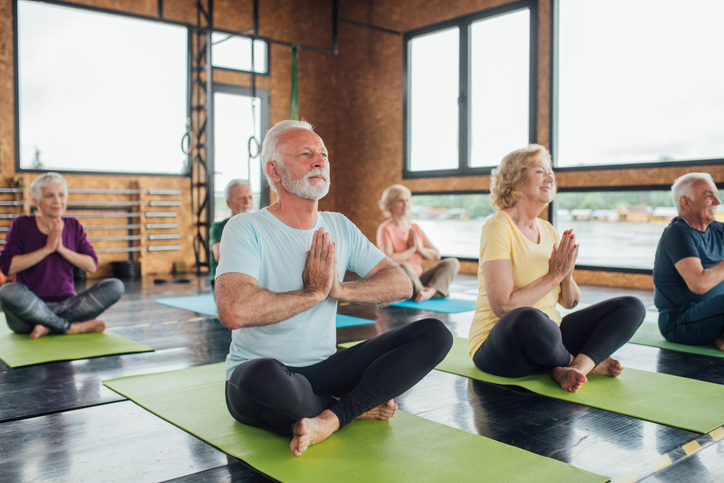Beginner Tips for Meditating

Meditation is a great way to find an inner sense of peace and get in touch with the present moment. We have all seen the peaceful calm on a person’s face as they meditate- but where do you even begin? To a beginner, joining the world of meditation can seem complicated and even intimidating. Don’t let that fool you- meditation is accessible to everyone and very easy to get started with.
You don’t need any equipment or expertise to begin meditating. The fun part is you will start to see results right away.
What and How
Meditation is a sitting activity that involves deep breathing and relaxed focus. While sitting in this peaceful silence, meditators will often note decreased levels of stress and anxiety. Long-term benefits include anger reduction, stress management, and many other physical benefits. Meditation brings a peaceful calm of presence, and can begin to show up in other areas of your life as well.
There are endless types and styles of meditation- in some instances meditators will choose an image or a chant to focus on during their meditation as a way to guide their focus. But for a beginner it’s great to start with the basics and focus on a quiet, breathing meditation.
Meditation can be done nearly anywhere, as long as there is a place you can sit to find stillness for some time. The key is to find and maintain a sense of peace and stillness. Many experts suggest picking a time of day each day you will meditate to establish a sense of continuity. Stick to this schedule and your mind will begin to adjust to the new activity more easily.
Posture: Sitting in a cross legged position is the most common and notable meditation posture, although if that is too painful or uncomfortable, sitting in a chair or lying down can be helpful. Whichever position, try to remain still from movement during the meditation. Cushions are great props to help boost or support certain areas while you are sitting. Often meditators will put cushions under their hips or knee areas to support their legs, which can get cramped during a long sit.
If you want more detailed instructions, this article is a great resource.
Instructions:
Sit or lie down in a position that is comfortable and will not require much adjustment. Place your hands lightly on your thighs.
Close your eyes or gaze softly at a distance about 4 feet ahead of you on the floor.
Let everything fall away from your mind. Try to let go of worries and thoughts.
Begin to pay attention to your breathing. Notice the rise and fall of your chest, and how the breathing feels.
Follow your breath in.
Follow your breath out.
If your mind strays or begins to think, do not get upset, but notice you were thinking and then bring your attention back to your breath.
Breathe in.
Breathe out.
Continue to focus on breathing for 10 minutes.
Try not to think as you do this. If your mind continues to think even as you focus on the breathing, notice it is thinking and then recommit to breathing and paying attention to breathing. Each time you recommit your focus becomes that much better, and eventually your mind will not wander as much.
For beginners, it is suggested to start with a short meditation- 10 minutes is a good starting point. Once that begins to feel comfortable or easy, lengthen the meditation and aim for 20 minutes. See how long you can sit in stillness without becoming agitated. It is not uncommon for some meditation styles to sit for an hour at a time. But this is all about you- find what works for you and what feels most helpful for your needs.
Am I doing it right?
For some, meditation comes quite smoothly and sinking into relaxation is easy. For others, it can take some effort. That is completely natural. If you encounter feelings of restlessness or negative thoughts that arise while meditating, try to notice them but don’t pay attention to them. Often the mind will have difficulty adjusting to a new task and might feel vulnerable in the beginning. When these feelings come up, notice them and then continue to focus on your breath. Use your breath as an anchor point when anything threatens to disturb your stillness. The feelings of discomfort will eventually pass.
Benefits Inside and Out
Studies have long since shown that meditation and mindfulness can have a dramatic impact both mentally and physically. People find they have better and deeper sleep, improved focus, and reduced stress and tension levels. In a survey conducted by the meditation program Headspace, 40% of users reported decrease in depression symptoms after 8 weeks and 30% reported decrease in anxiety and stress within a month.
Being Alone with Others
If you need a little accountability to get going but don’t have anyone around, there are some great tutorials on websites like YouTube that show how others begin meditation. For a more organized experience, look for a local meditation class where you can sit with others in silence. Many of these groups now have zoom offerings for distance meditation. Knowing others are there with you can be helpful on days when focus is difficult.
The nice part about meditation is it’s a great stopgap when there’s some free time- if you arrive early to an appointment or have some time to spare- you can sit down, close your eyes and bask in the stillness. Try to keep this feeling of mindfulness with you even when you aren’t meditating. It can really change your life.
Related Posts

Podcast: A Day in the Life at Era Living – Resident Diane Miller

Podcast: Advocating for Retirees in Senior Living

